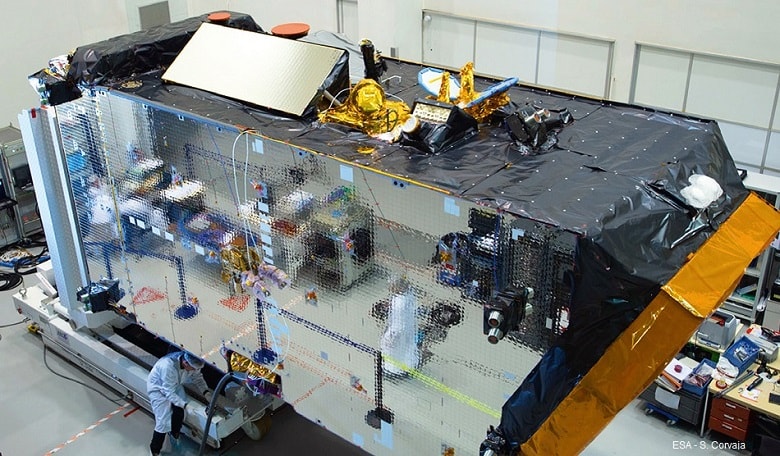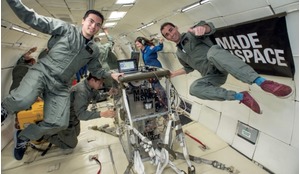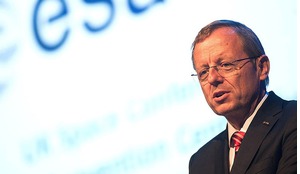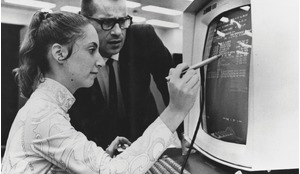Satellite communications are the mainstay of the space industry: more than half of the space business involves building and launching communication satellites. Satcoms services and applications are the largest space sector and are a major driver of space technology and developments.
Adding up all stages in the satcoms value chain, an aggregate of around €100 billion per year was the worldwide satcoms value in 2013. This figure continues to grow.
Half of the satellites being launched are communication satellites, with 60% of those satellites procured by commercial operators. Owing to the larger size and complexity of communications satellites, their value represents more than 2/3 of the value of all satellites launched (67% in 2012). Also, they represent the bulk of the commercial launches: 87% of Ariane launches in the last three years were satcoms.
Satcoms represent a major commercial investment. The cumulated CAPEX of the European top four satcom operators in the period 2000-2012 was $25 billion.
The entire space industry benefits from an active satcom global market: it would not be realistic to maintain know-how and industrial tools without the sustained activities of the commercial satcoms sector.
As there is a direct relation between sales and employment, the satcoms sector can be described as supporting two-thirds of the space industry jobs in Europe. Knowledge, know-how, and industrial tooling are maintained thanks to commercial satcom activity.
Not to mention the fact that we can also add the direct and indirect employment in the satcom applications and services sectors to the above.
Satcoms, as a driver and enabler for economic growth and jobs, is fully in-line with a knowledge- and innovation-based economy, providing services with huge socio-economic impact.
Competition and the ESA ARTES programmeFor satcoms, the main growth is in export markets: Russia, Latin America, Asia, Africa, and the Middle East.
Strong competition among global and national/regional satcoms operators reduces profitability, putting pressure on satellite prices, which is also transferred to satellite integrators, launch service providers and equipment suppliers.
New technologies, capabilities and entrants into the market, both satellite and terrestrial, are expected to increase competition, driving prices lower even as demand increases.
Satcoms operators are forced to innovate in the procurement of satellites and require powerful, optimised solutions and flexibility from satellite integrators. Innovation at all levels is key for satcoms and is essential for maintaining the market share of European manufacturers responding to challenging requirements of their customers.
ESA addresses this key sector via its Advanced Research in Telecommunications Systems (ARTES) Programme.
The satcoms sector supports two-thirds of space industry jobs in Europe
In Europe, there is no equivalent to the US Department of Defence programmes that, despite diminishing budgets, continue to inject the equivalent of several times the European combined budget into the US satcom value chain.
ARTES supports R&D developments ranging from products to services with European satcom actors across the full value chain (SME’s, primes, operators, and service providers). Operators are also partners of ESA in supporting R&D development.
Alphasat is the most sophisticated European telecom satellite right now
In a very competitive environment, where advance in technology is key, R&D is of outmost importance and flight heritage is of key importance. Public–Private Partnerships (PPPs) with operators and industry are a large part of ESA’s ARTES programme, being a most efficient means for flight proving advanced European technology in orbit (the competitors of European industry benefit from reserved government markets for flight proving their technology).
Today, there is an insatiable need for low-cost bandwidth
Specific programmes such as Hylas-1, Alphasat, SmallGEO, EDRS and SAT-AIS are structured as PPPs. The PPP approach allows industry to take on a greater risk in order for Europe to reap the benefits of advanced satellite technology.
The market drives, and is driven by, technologyToday, there is an insatiable need for low-cost bandwidth to allow for satellite broadcasting, internet communications, trunking video, voice and data, and a plethora of mobile applications.
This requires innovative payloads and platforms adapted to different types of missions. ARTES supports the development, qualification and demonstration of platform or payload equipment and sub-systems, user terminals, and even full systems integrating a network with its space segment to provide comprehensive solutions.
The ARTES Alphabus/Alphasat programme is a good example of development addressing concrete market needs.
Alphasat is a PPP undertaken with Inmarsat, carrying a next-generation advanced geomobile communications payload in L-band as well as four ‘hosted’ technology demonstration payloads. It was built under Astrium (now Airbus DS) prime contractorship and it is the most sophisticated European telecom satellite ever built, exceeding 6.6 tonnes at launch, with its solar array, spanning 40 m, generating more than 12 kW of power.
The programme included the development of highly innovative payload technologies – such as the advanced digital integrated processors developed by Astrium – that are core elements of the advanced geomobile L-band payload, allowing unprecedented flexible allocation of capacity through digital channellisation and beam-forming. It is a major step in payload operational capability.
The Alphasat Digital Integrated Processor providing payload flexibility through coverage and power reconfiguration capabilities, responds to an ever varying market demand by directing capacity resources where they are needed in the coverage.
Alphasat uses the high-power, multipurpose Alphabus platform addressing the large-payload market and meeting demand for increased broadcasting services. It can accommodate commercial missions with up to 22 kW of payload power and mass of up to two tonnes.
In the platform area, ESA supports European industry competitiveness across all market segments. The ARTES Small GEO programme addresses the market segment below 3 tonnes mass, while Alphabus addresses the high-end segment above 6 tonnes. Small GEO is being developed in a PPP within ARTES by an industrial team managed by OHB System AG and its first use is for Hispasat’s Advanced Generation 1 satellite.
Meanwhile, the 3 to 6 tonnes market segment (representing around 80% of the total platform market) is addressed by the Neosat programme in ARTES, including production and supply chain optimisation, and addressing challenging market needs such as increased productivity, shorter delivery schedules, and reliability.
The market demand for full-electric satellites is addressed by the ARTES Electra project which encompasses both the development of a full–electric propulsion platform and the implementation of a mission in partnership with SES. Compared to chemical propulsion, full-electric propulsion weigh less, letting operators choose between a lighter spacecraft or one with more payload, even though it takes longer to reach the desired orbit and enter service.
Alphasat also hosts Technology Demonstration Payloads addressing various market and R&D requirements. These include a Laser Communications Terminal for high data-rate optical LEO-to-GEO links at rates up to 2.8 Gbit/s,and a Q/V band payload preparing the commercial exploitation of Q-V Band, in response to the market demand for high data rates and more bandwidth.
Also hosted is an Advanced Star Tracker, which uses active pixel technology.
A crucial link-up in spaceThe Laser Communications Terminal and downlink system on Alphasat and its counterpart on Sentinel-1A EO satellite, flying at a 700Km orbit, have linked up to deliver images of Earth just moments after they were captured.
Marking a first in space last November 28th, this important step demonstrates the potential of Europe’s new space data highway to relay large volumes of information very quickly so that information from Earth-observing missions can be even more readily available.
Such technology will also be used on the European Data Relay System (EDRS), developed under another ARTES PPP. EDRS will provide a telecommunications network that is fast, reliable and seamless. It will make real-time data from satellites available on demand at the right place at the right time.
In the platform area ESA supports a competitive European industry across all market segments
Airbus DS has the overall responsibility for designing and developing the complete space and ground infrastructure. Airbus DS is also committed to its operation for the next 15 years.
Addressing production methodsImproved production methods are another important issue for continued growth.
For example, responding to the market requirement for shorter delivery schedules, and using ESA/ARTES support, Thales Alenia Space developed an efficient electromagnetic compatibility (EMC) test method for telecom satellites, based on a mobile, flexible conductive tent that can be placed over the entire payload, and using reverberation chamber methods for detection of RF leakage.
For highly complex payloads, this is a big time-saver – up to several weeks. The system is expected to become a standard TAS way to test EMC and has already been used to test the AT1, AT2, Yamal-401, Athena–Fidus and W3D satellite payloads.
We would also like to highlight a new approach for testing large antennas, developed with ARTES support by Airbus DS.
EDRS will provide a fast new telecoms network
It avoids the need for far field ranges or cumbersome near-field facilities by developing a Portable Antenna Measurement System (PAMS) that enables the antenna to be tested without removing it from the cleanroom in which it was built.
Satcoms have a huge impact on society and the economy and provide developing nations with immediate access to advanced technology
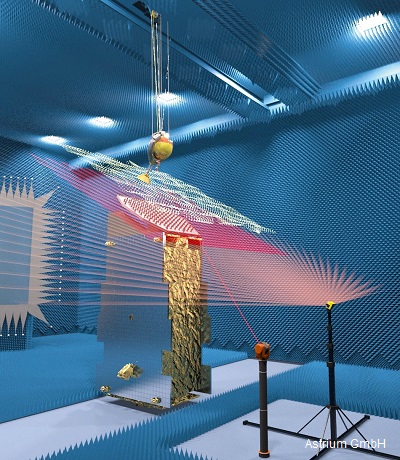 PAMS will test antennae directly from the cleanroom
PAMS will test antennae directly from the cleanroom
This places the measurement system inside a gondola suspended from existing cranes within the assembly hall and using an off-the-shelf laser tracker for precise localisation of the gondola.
Changes on the groundInnovation is also needed in the ground segment. For example we need to look for more efficient ways of using available frequencies.
New techniques developed in ARTES projects have achieved improved bandwidth efficiency (up to 250% over the previous generation) resulting in impressive savings in bandwidth costs. Within ARTES, STM Norway developed gateway and VSAT modems providing a low-cost answer for highly dynamic, demand-driven transmission capacity.
Global Invacom can stream six TV programs
The modems can provide dynamically more than 150 Mbit/s on the outbound link, and up to 24 Mbit/s on the inbound link, well in excess of terrestrial ADSL or cable connections. This technology is currently deployed for 30 satcom services worldwide.
Many technical features of these new modems are directly derived from past ARTES projects, including higher-order modulations, advanced forward error correction schemes, adaptive coding and modulation on both inbound and outbound links, Internet Protocol- friendly link layer encapsulation, and efficient framing of data.
Satcoms and socio-economic issuesAlthough this is often overlooked, satcoms have a huge impact on society and economy.
Close to half a billion households worldwide receive more than 37.500 television programmes directly from geostationary satellites. Of these, about 40% are in emerging countries. In Europe alone, 80 million households receive information and entertainment directly via satellite TV, while cable TV is fed by satellite for another 66 million households.
ARTES supports R&D for products to deliver the next generation of TV services, including 4k.HDTV, Ultra HDTV, stereoscopic and multi-view 3DTV.
For example, ARTES supported Newtec M6100 Broadcast Satellite Modulator, which provides more efficient and adaptable ways of processing signals for digital TV broadcasting at a lower cost. This not only increases reliability and expands bandwidth usage, but also reflects the ever-evolving nature of the telecom business by being “future proof” – a platform with technology for systems that have yet to be built (it collected the 2013 Teleport Technology Award for Excellence in Washington).
Satellite television has become a fixture of modern life, but consumers want to be able to watch TV on different devices at various locations around their homes.
An ARTES supported Global Invacom system, based on SES- Astra’s SAT-to-IP protocol developed with support from ARTES, makes it possible to stream up to six different television programmes simultaneously and can be configured for 32 end-users for a total of 192 channels without requiring separate satellite decoder boxes or extensive coaxial cabling.
Satellite broadband, as the only way able to connect users, immediately and cost-effectively, no matter where they are located – mountains, islands, remote or sparsely populated areas – was the key to helping the European Commission achieve its 2013 Digital Agenda for Europe target of 100% coverage with basic broadband.
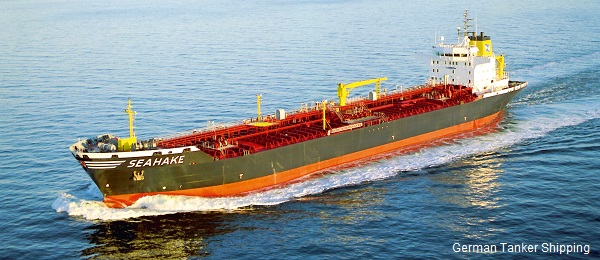 Today, ARTES supports maritime broadband with MediaMobil/SASS@Sea
Today, ARTES supports maritime broadband with MediaMobil/SASS@Sea
Development of the world’s poorest countries is empowered through access to communications technology via satellite communications. Through satcoms, developing nations have immediate access to some of the world’s most advanced technology. For example, modern communications satellites can provide African users with access to technologies - such as broadband connectivity, IP data, and 3G communications – in a highly cost-effective manner.
An example is the ARTES SatFinAfrica project, supporting African countries with money transfer branches and ATMs, each equipped with a satellite terminal to connect the outposts, providing small local businesses with the financial services needed to grow.
Satellites offer the only connection available in the high seas. And internet connections on planes, cruise ships and oil platforms are made possible via mobile satcoms.
Another maritime application example is the European-based SAT-AIS, an ESA initiative in partnership with EMSA, the European Maritime Safety Agency, and industry. Within ARTES, ESA has started the development of 2 micro-satellites supporting the SAT-AIS network of satellites in cooperation with LUXSPACE and exact Earth Europe.
In case of emergency…It is important to understand that satcoms also provide lifesaving services. Maritime distress signalling is a lifesaving service made possible by satcoms, for example.
Satellite communications dramatically impact our ability to effectively plan, coordinate and respond to emergencies and natural disasters. At times of disaster, when other communications systems are either destroyed or overloaded, satellite communications equipment can be used immediately to support relief efforts.
In the aviation sector, the ARTES Iris programme will contribute to the modernisation of air traffic management by providing digital datalinks to cockpit crews in continental and oceanic airspace.
ESA is implementing the design phase of Iris in cooperation with the European Commission, the SESAR Joint Undertaking, Eurocontrol, European space industry, air navigation service providers and aviation stakeholders.
Military and security infrastructureMaritime distress signalling is a lifesaving service made possible by satcoms
Satcoms can also support peacekeeping missions, and provide aid to troops abroad and border security around the world. Satellite connections are typically the only link remote troops have to home and provide probably the most robust communications solution for use in a security or military environment. Satcoms are a building block for the Common Security and Defence Policy.
Autonomy of decision making and of actions at an EU level requires autonomy of operational infrastructures and of access to information. Satcoms’ capacity to instantly cover most of the world, to provide a back up to strategic communication, to provide secure and resilient communication are thus crucial.
No such services could exist without communication satellites in orbit, which require substantial investment by both industry and operators.





